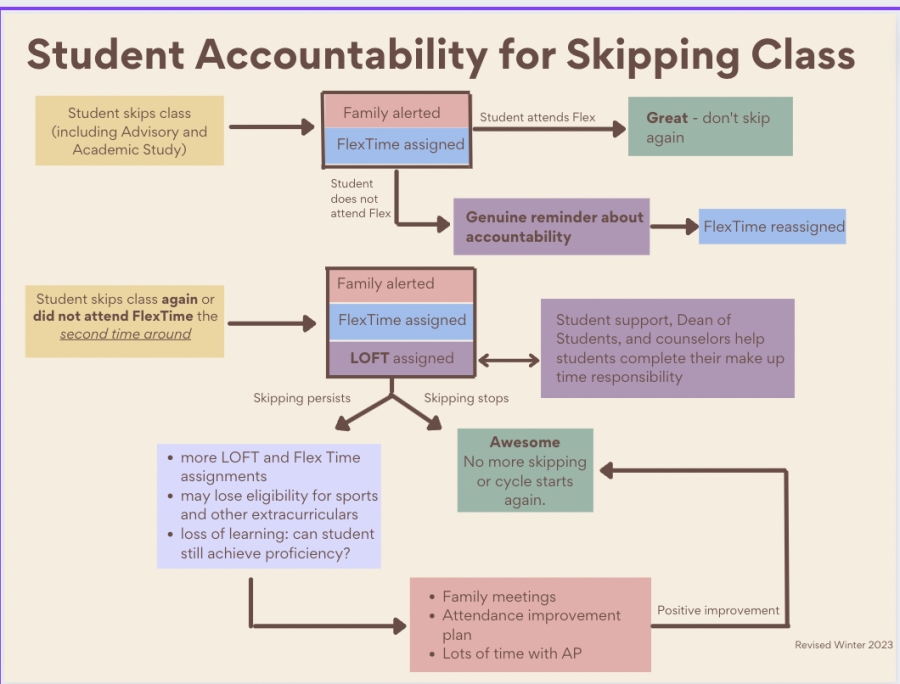New procedure combats unexcused absences
March 26, 2023
BHS has implemented a new attendance procedure to combat the high levels of unexcused absences. Students who skip class will be assigned to Flex Time where they will catch up on the missed learning and their parents will be called to inform them of the absence. Failure to attend FlexTime will lead to mandatory Loss of Learning Time (LOFT) which is after school detention dedicated to work completion.
Ben Heintz started teaching English at BHS this year and is in favor of the new procedure.
“Coming from another school, it was really striking to me how poor the culture of attendance is here,” Heintz said. “I thought that [a new procedure] was very much needed.”
Heintz sees a positive response from families and believes the calls to be beneficial.
“Since the procedure started, I have called home probably a dozen times and each time I have gotten a response,” Heintz said. “I think it works well to connect with the families, for the parents to know and for a lot of the kids, I think that’s all they really needed.”
A BHS teacher, who prefers to remain anonymous, believes that the procedure disproportionally affects faculty who are teaching
electives and core classes who face more problems with student attendance.
“In theory, I do think we need to have better attendance and it does need to be strengthened and taken seriously,” the teacher said. “However the attendance system as it is [now] is requiring to teachers to make phone calls to every absence, do an entry into PowerSchool for every absence, request people for flex time for every absence and assign people to LOFT for
every absence.”
This teacher says they spend around three hours each week to make the necessary connections. Furthermore, out of the 20 phone calls home, only three resulted in students attending the next class period.
“I have a lot of classes. I have a lot of grading to do. I find myself feeling extremely overwhelmed by the number of communications that I need to do with the missing students as a part of the new procedure.”
Social Studies teacher Brennan Carney was a part of the committee that crafted the procedure.
“[The process] was hours and hours of meeting,” Carney said. “Building it out, drafting it, explaining it… in the end I don’t think [we] are ever going to get it right; there is no perfect system.”
Heintz understands the time commitment to keep the new procedure running and successful, but believes
that the solution is pushing through and let it become routine.
“I think the key is for every teacher to consistently follow through right now at the beginning, and that’s a big ask because it’s a lot of extra time and teachers have so many other things on their plate,” Heintz said. “But if every teacher can really do it for a month or two and follow through, I think we can change the culture here around attendance.”
Carney believes that some students need the extra push to understand why attendance is so critical to success.
“How do we get someone who doesn’t know what success is to value something that they don’t realize they need?” Carney said. “[Attendance is] a very tangible issue that leads to other issues. If we can wrangle attendance, we can wrangle other problems as well.”























![Check out Rose Howell's article "Teaching Conflict": https://bhsregister.com/9661/news/teaching-conflict/
“I know that some people have colleagues who disagree with me because they don’t think these conversations should happen in school, [but] where else should they happen then?” ~Social Studies teacher Francesca Dupuis](https://scontent-ord5-1.cdninstagram.com/v/t51.29350-15/404979361_1569222083889381_8162261023681050366_n.jpg?_nc_cat=101&ccb=1-7&_nc_sid=18de74&_nc_ohc=RHOhiTkucIgAX9i9OIz&_nc_ht=scontent-ord5-1.cdninstagram.com&edm=ANo9K5cEAAAA&oh=00_AfDvefW7hOPJEWQXiafhqZSFlGqW7IQC9rpAVV3pFKgt8w&oe=65B50250)
